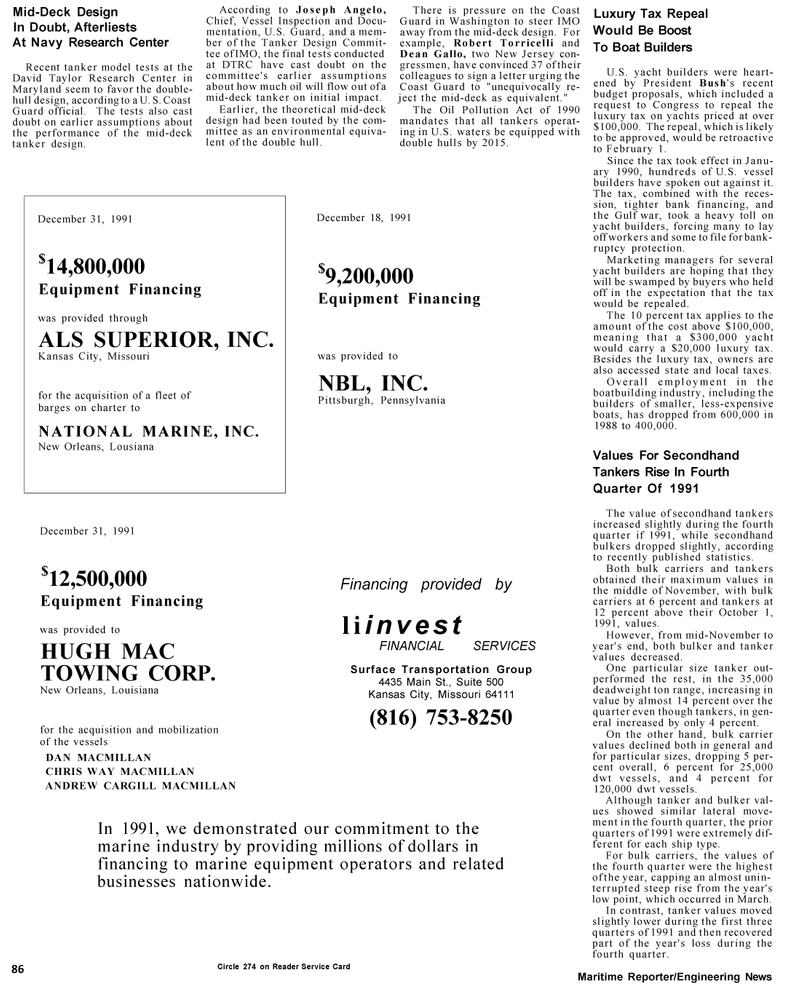
Page 30: of Maritime Reporter Magazine (March 1992)
Read this page in Pdf, Flash or Html5 edition of March 1992 Maritime Reporter Magazine
Mid-Deck Design
In Doubt, Afterliests
At Navy Research Center
Recent tanker model tests at the
David Taylor Research Center in
Maryland seem to favor the double- hull design, according to a U. S. Coast
Guard official. The tests also cast doubt on earlier assumptions about the performance of the mid-deck tanker design.
According to Joseph Angelo,
Chief, Vessel Inspection and Docu- mentation, U.S. Guard, and a mem- ber of the Tanker Design Commit- tee of IMO, the final tests conducted at DTRC have cast doubt on the committee's earlier assumptions about how much oil will flow out of a mid-deck tanker on initial impact.
Earlier, the theoretical mid-deck design had been touted by the com- mittee as an environmental equiva- lent of the double hull.
There is pressure on the Coast
Guard in Washington to steer IMO away from the mid-deck design. For example, Robert Torricelli and
Dean Gallo, two New Jersey con- gressmen, have convinced 37 of their colleagues to sign a letter urging the
Coast Guard to "unequivocally re- ject the mid-deck as equivalent."
The Oil Pollution Act of 1990 mandates that all tankers operat- ing in U.S. waters be equipped with double hulls by 2015.
December 31, 1991 $14,800,000
Equipment Financing was provided through
ALS SUPERIOR, INC.
Kansas City, Missouri for the acquisition of a fleet of barges on charter to
NATIONAL MARINE, INC.
New Orleans, Lousiana
December 18, 1991 $9,200,000
Equipment Financing was provided to
NBL, INC.
Pittsburgh, Pennsylvania
December 31, 1991 $12,500,000
Equipment Financing was provided to
HUGH MAC
TOWING CORP.
New Orleans, Louisiana for the acquisition and mobilization of the vessels
DAN MACMILLAN
CHRIS WAY MACMILLAN
ANDREW CARGILL MACMILLAN
Financing provided by liinvest
FINANCIAL SERVICES
Surface Transportation Group 4435 Main St., Suite 500
Kansas City, Missouri 64111 (816) 753-8250
In 1991, we demonstrated our commitment to the marine industry by providing millions of dollars in financing to marine equipment operators and related businesses nationwide.
Circle 274 on Reader Service Card 86
Luxury Tax Repeal
Would Be Boost
To Boat Builders
U.S. yacht builders were heart- ened by President Bush's recent budget proposals, which included a request to Congress to repeal the luxury tax on yachts priced at over $100,000. The repeal, which is likely to be approved, would be retroactive to February 1.
Since the tax took effect in Janu- ary 1990, hundreds of U.S. vessel builders have spoken out against it.
The tax, combined with the reces- sion, tighter bank financing, and the Gulf war, took a heavy toll on yacht builders, forcing many to lay off workers and some to file for bank- ruptcy protection.
Marketing managers for several yacht builders are hoping that they will be swamped by buyers who held off in the expectation that the tax would be repealed.
The 10 percent tax applies to the amount of the cost above $100,000, meaning that a $300,000 yacht would carry a $20,000 luxury tax.
Besides the luxury tax, owners are also accessed state and local taxes.
Overall employment in the boatbuilding industry, including the builders of smaller, less-expensive boats, has dropped from 600,000 in 1988 to 400,000.
Values For Secondhand
Tankers Rise In Fourth
Quarter Of 1991
The value of secondhand tankers increased slightly during the fourth quarter if 1991, while secondhand bulkers dropped slightly, according to recently published statistics.
Both bulk carriers and tankers obtained their maximum values in the middle of November, with bulk carriers at 6 percent and tankers at 12 percent above their October 1, 1991, values.
However, from mid-November to year's end, both bulker and tanker values decreased.
One particular size tanker out- performed the rest, in the 35,000 deadweight ton range, increasing in value by almost 14 percent over the quarter even though tankers, in gen- eral increased by only 4 percent.
On the other hand, bulk carrier values declined both in general and for particular sizes, dropping 5 per- cent overall, 6 percent for 25,000 dwt vessels, and 4 percent for 120,000 dwt vessels.
Although tanker and bulker val- ues showed similar lateral move- ment in the fourth quarter, the prior quarters of 1991 were extremely dif- ferent for each ship type.
For bulk carriers, the values of the fourth quarter were the highest of the year, capping an almost unin- terrupted steep rise from the year's low point, which occurred in March.
In contrast, tanker values moved slightly lower during the first three quarters of 1991 and then recovered part of the year's loss during the fourth quarter.
Maritime Reporter/Engineering News

 29
29

 31
31
